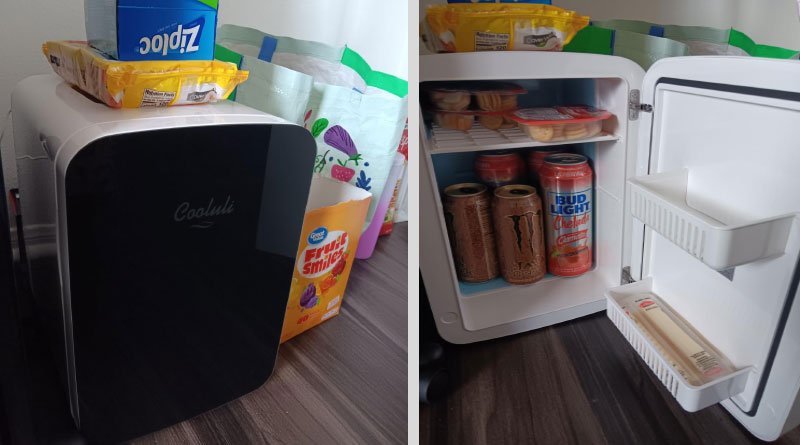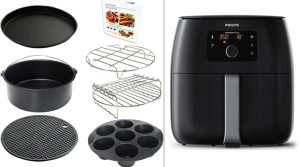Can You Stack Mini Fridges: Big Solutions for Small Spaces
Question on many minds is, Can you stack mini fridges? Have you ever found yourself in need of additional refrigerator space but faced with limited room to spare? The hustle and bustle of a college semester or the charm of a cozy small apartment can quickly fade when you’re faced with the perennial problem of space.
Learning to make the most of every square inch becomes a skill in itself for students and apartment dwellers alike. Enter the savvy solution of stacking mini fridges – a game-changer for those who need to save space without sacrificing on everyday comfort and convenience. we delve into the world of mini fridge stacking, a technique that can turn a cluttered mess into an organized oasis.
We’ll explore the intricacies of this space-savvy approach, offering practical advice and considerations that will help transform your cramped quarters into an efficient and enjoyable living space.
Can You Stack Mini Fridges: 5 Creative Ways?
Are you tight on space but still looking to keep your food and drinks cool and fresh? Mini fridges are a staple for those in compact living situations like college dorms, small apartments, or tiny homes. But what if you need more than one? The solution lies in the versatility of stacking mini fridges. Here, we’ll explore five creative ways you can stack your mini fridges, ensuring that you make the most out of your space while keeping everything you need at the perfect temperature.
1. Stackable Mini Fridges
When you’re in the market for a new mini fridge, consider models that are designed for stacking. These fridges have a flat top and a grooved bottom, making it safe and easy for one unit to sit atop another.
The advantage of stackable mini fridges is not only their compatibility but also their sleek and space-conscious design. They often come in various shapes and sizes, so you can mix and match to suit your specific needs. Look out for ones with reversible doors for added flexibility in your space.
2. DIY Stacking Methods
Who says you need to buy special fridges to stack them? With a bit of creativity and some simple materials, you can craft your own stackable setup. Here are a few DIY stacking methods to consider:
Shelving Units: Use sturdy shelves to create a multi-tiered storage area perfect for stacking your mini fridges. Select shelves with the appropriate spacing and weight capacity to safely support the fridges.
Sturdy Crates: Stack durable, wooden or plastic crates to create a stable base for your fridges. Make sure the materials are strong enough to handle the weight of the fridges and any contents.
Custom-Built Frames: If you’re feeling particularly handy, you can build a custom frame out of wood or metal to precisely fit your mini fridges. This method allows you to tailor the setup to your space while ensuring the stability of the structure.
3. Safety Considerations
Stacking mini fridges can be a fantastic space-saving solution, but it’s essential to keep safety at the forefront. Here are some factors to consider:
Weight Distribution: Ensure that the weight of the stacked fridges is evenly distributed to prevent tipping. Placing heavier items on the bottom fridge can help maintain balance.
Stability: Whatever stacking method you choose, be sure that the set-up is stable and not prone to wobbling. If you feel any movement, reconfigure the setup to be more secure.
Clearance for Ventilation: Mini fridges need proper ventilation to operate correctly. Allow for sufficient space around the refrigerators and ensure there are no blockages to the vents, especially if you’re using DIY method where the fridges are not directly stacked.
4. Space Optimization
Stacking mini fridges is all about maximizing the space you have. Here are some space optimization tips for your stacked fridges:
Utilizing Vertical Space: Take advantage of the height that stacked fridges provide. Use bins or storage containers to keep food organized, and make sure that items are grouped by frequency of use, with the most-used items at eye level.
Organizing Items Efficiently: Do a mini declutter every week to ensure items don’t get lost in the back. Keep taller items on the top fridge, and use the lower one for bulkier items or those you don’t need to access as often.
5. Alternative Storage Options
If stacking mini fridges isn’t a viable option for your space, there are still ideas that can help you store your essentials effectively:
Under-Bed Storage: Invest in under-bed storage boxes or bins to keep non-perishables and extra supplies out of sight and out of the way.
Wall-Mounted Shelves: Utilize wall space with sturdy, wall-mounted shelves to store kitchen equipment and non-refrigerated items. This frees up floor and counter space for other uses.
Over-Door Organizers: Maximize every inch of space by adding over-door organizers to store small items, utensils, or snacks. These are ideal for the inside of pantry doors or bedroom closets. Stacking mini fridges can be both a space-efficient solution and a creative way to organize and store your food and beverages. It requires thoughtful planning, especially when it comes to safety and clearance, but when done right, it can greatly enhance the functionality of your compact living space. Whether you opt for a purpose-built stackable model or take the DIY approach, these tips will help you stack with confidence.
Art of Elevating with Stacked Mini Fridges
Maximizing Limited Space: When every inch counts, stacking your mini fridges provides an immediate vertical expansion. Instead of juggling multiple appliances across a room, stackable fridges consolidate your chilled goods into a tower of efficiency. This extra floor space can be repurposed for seating, study areas, or just to give the room a more spacious feel.
Creating Additional Storage Options: Stacking isn’t just about saving space; it’s about increasing your storage potential. With multiple units easily accessible at various heights, you can categorize your groceries or beverages more effectively. A top fridge might store your beverages, while the bottom one could house your perishables and snacks, all within arm’s reach.
Convenience and Accessibility: Gone are the days of bending down to reach the crisper or climbing a step stool to grab a drink from your high-capacity fridge. With stacked units, daily use items can be stationed at eye level, minimizing effort and streamlining your daily routine.
Foundations Before Ascension
Weight and Stability: The most crucial factor to consider when stacking mini fridges is the structure’s ability to support the combined weight. Always check the maximum load capacity of your top fridge. It’s advisable to consult with an expert or the manufacturer to ensure that the furniture or stand you use can bear the load.
Proper Ventilation: Mini fridges, like their full-sized counterparts, require proper ventilation to function efficiently. Stacking should never impede the free flow of air to the condenser and evaporator coils. Make sure there’s at least 5 inches of space between the back of the fridge and the wall to prevent overheating.
Power Supply and Electrical Safety: Each fridge should have its own power outlet. Overloading a single outlet with multiple appliances can lead to shorts, damage, or create fire hazards. Use power strips with surge protectors to distribute electricity consistently and protect your fridges against unexpected power surges.
Building Tower of Chill: Guide to Stacking
Clearing and Preparing the Area: Before stacking your fridges, declutter and clean the area where your stack will stand. This not only facilitates the stacking process but also ensures a safe and hygienic setup for your food and drinks.
Ensuring Level and Secure Placement: Use a level to ensure that the area is even and that each fridge you stack is placed squarely on the unit below. Shims can be used to fill in any gaps if needed, providing a more secure and stable stack.
Connecting and Aligning the Fridges: Each mini fridge’s feet may need adjusting to ensure they are the same height, once again, promoting stability and safety. Once level, you can secure the fridges together using brackets, shown in the manual of some units, to prevent them from shifting.
Safety Precautions: Safety first. Never stack fridges too high – two is usually the maximum for stability’s sake. Use only equipment designed for stacking, and make sure it’s well-maintained. Regularly check the levels and tightness of connections to keep everything secure over time.
Case Studies: The Real-Life Cooler Utility of Stacks
Success Stories of Stacked Fridges
Hear from those who’ve successfully integrated stacked fridges into their small living spaces. Learn from their experiences and adaptations to find what works best for you.
Designs That Stand Out
The market is brimming with options catering to varied aesthetics and functionalities. Explore the latest stackable mini fridge designs and features that could align with your personal tastes and practical needs.
Durability Debate: Brand and Quality Matter
Not all mini fridges are created equal. Some brands offer better stability and support for stacking. Investigate the best brands known for their durable and safe stacking capabilities.
Eco-Friendly Elevations: The Energy Efficiency Factor
Two fridges are better than one – if you manage their power consumption properly. Discover the energy efficiency of stacked fridges, helping you save space and reduce your carbon footprint.
Frosty Financial Fractions: The Cost of Stacking
Dive into the economics of stacked fridges. Are the initial costs justified by long-term convenience and space-saving benefits? We break it down in a cost comparison of stacking versus traditional fridge models.
Expert Endorsements and User Testimonials
Expert opinions can provide an external gauge of stacking safety and practicality. Additionally, user testimonials offer inside looks into the daily functionality of stacked mini fridges.
Final Verdict
The practice of stacking mini fridges can be a revolutionary solution to the space quandary faced by many. By understanding the benefits, preparing thoughtfully, and approaching the setup with caution, you can begin to transform your living space into a more comfortable and efficient environment.
Stackable fridges offer a myriad of advantages, from maximizing space to offering additional storage and enhanced convenience. Yet, it’s crucial to adhere to safety guidelines and ensure the quality of the products and setup.
It may seem like a small change, but the decision to stack mini fridges represents a larger mindset of adaptability and efficiency. Take this as a proactive step in creating a space that not only functions optimally but also reflects your personal style and values.
the space-saving journey is as crucial as the destination. With the right preparation, equipment, and mindset, stacked mini fridges can be the stepping stone to a more streamlined and enjoyable living experience.
FAQs of Stack Mini Fridges
Q: Can I stack two mini fridges on top of each other?
A: In general, it’s not recommended to stack mini fridges. The weight can cause damage to the lower fridge, and it could also pose a tipping hazard.
Q: Why shouldn’t I stack mini fridges?
A: Apart from potential damage and safety hazards, stacking can also cause overheating issues. Mini fridges need space around them for ventilation to dissipate heat.
Q: How can I maximize space if I can’t stack my mini fridges?
A: Consider placing your mini fridges side by side or in separate locations. You could also use shelving units or a sturdy table to elevate one fridge without placing it directly on the other.
Q: What if I really need to stack my mini fridges due to space constraints?
A: If you absolutely have to stack them, consider using a heavy-duty wire rack or shelf between them to distribute the weight evenly and allow for ventilation. Make sure the setup is stable to avoid any tipping risk.
Q: Are there any mini fridges designed to be stacked?
A: Some commercial-grade mini fridges are designed to be stackable, but these are typically more expensive than standard mini fridges. Always check the manufacturer’s instructions before stacking appliances.







